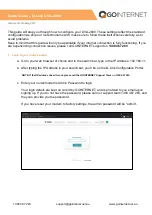
5 PTC-Firmware
5.8.4
Notes about NAVTEX practice
The PTC-IIex normally operates with 200 Hz shift for FSK operation. Although
NAVTEX uses 170 Hz shift, it is not necessary to change the modem tone settings for
NAVTEX reception. The loss due to the slightly maladjusted shift being in the area of
tenths of a dB, and can be ignored for practical purposes.
When using the usual modem tones of 1400 Hz and 1200 Hz (Low-tones,
TOnes
parameter 0), the receiver should be set to USB and a frequency of 516.700 kHz to
receive NAVTEX on a center frequency of 518 kHz. For LSB the frequency should be set
to 519.300 kHz. Here, the
TR
parameter (see chapter
Basically, the same conditions for NAVTEX reception are required as for AMTOR-FEC.
The parameters
BC
and
ARX
must both be set to 1. (these are the default values. Refer to
).
5.8.5
AMTEX
The American Radio Relay League (ARRL) has used one system (among others) for its
radio bulletins via HF radio for a number of years, which closely resembles the maritime
NAVTEX system, and follows the same protocol rules. It is called AMTEX. This amateur
radio NAVTEX differs only in its special definition of possible message types, which
have been adjusted for amateur radio usage. The existing NAVTEX processor in the
PTC-II is thus very suitable for fully automatic reception of AMTEX transmissions,
provided suitable adjustments are made. The messages are transmitted (as with
NAVTEX) in AMTOR FEC ("mode B") normally from 1800 and 2100 American local
time (i.e. 2300 and 0200 UTC - or one hour earlier during summer time). The AMTEX
transmissions take place on the frequencies of 3625, 7095, 14095, 18102.5, 21095 and
28095 kHz (Mark). The following message types have been defined to date:
E: DX
News
Bulletin
G:
General News Bulletin
K:
Keplerian Data Bulletin
P: Propagation
News
Bulletin
S: Space
Bulletin
X: Special
Bulletin
Table 5.6: AMTEX message types
Generally, "A" is used as the area code (Station ident). Exceptionally, "S" has been used.
5.9
GPS
The "Global Positioning System" (GPS) has very quickly become a standard for all areas
that require exact positional information e.g. shipping, in-car navigation systems etc.
Today, GPS receivers are cheaply available and widely used. The PTC-IIex offers the
possibility to link the GPS technology with PACTOR, and also to PR. It now becomes
possible for example to call up the present position of small ships or deep sea yachts via
shortwave, without requiring a PC to be running on the mobile station and without a ships
radio operator.
30
Summary of Contents for PTC-IIex
Page 14: ...List of Figures and Tables XII...
Page 30: ...3 Installation 16...
Page 108: ...7 Audio 94...
Page 126: ...8 FAX 112...
Page 173: ...12 SYStest 159...
Page 183: ...14 Circuit Description 169...
Page 195: ...15 Basics 181...
Page 201: ...B Technical Data 187...
Page 202: ...C Layout Appendix C 19 Layout B 1 Motherboard Figure B 1 Motherboard 188...
Page 203: ...C Layout 189...
Page 215: ...Index 202...
















































